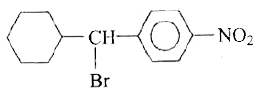SN1 reaction is fastest in
CH3CH2Br
CH3−CH∣Cl−CH3
CH3−CH3C∣∣CH3−Cl
CH3−CH∣CH2∣CH3−Cl
The correct Answer is:C
To determine which compound undergoes an S1N reaction the fastest, we need to analyze the stability of the carbocations formed during the reaction. The stability of carbocations is crucial because the rate of the S1N reaction is dependent on how easily the carbocation can form.
1. Understanding S1N Mechanism:
- The S1N (Substitution Nucleophilic Unimolecular) reaction involves two main steps:
1. Formation of a carbocation after the leaving group departs.
2. Nucleophilic attack on the carbocation.
2. Carbocation Stability:
- The stability of carbocations follows this order:
- Tertiary (3°) > Secondary (2°) > Primary (1°) > Methyl.
- The more stable the carbocation, the faster the S1N reaction will proceed.
3. Analyzing the Given Compounds:
- Option 1: CH₃CH₂Br (Ethyl bromide):
- When Br leaves, it forms a primary carbocation (CH₃CH₂⁺), which is the least stable.
- Option 2: CH₃CH(CH₃)CH₂Cl (Isobutyl chloride):
- When Cl leaves, it forms a secondary carbocation (CH₃C⁺H(CH₃)₂), which is more stable than a primary carbocation but less stable than a tertiary one.
- Option 3: CH₃C(CH₃)₂Cl (Tert-butyl chloride):
- When Cl leaves, it forms a tertiary carbocation (CH₃C⁺(CH₃)₂), which is the most stable.
- Option 4: CH₃CH(CH₂CH₃)Cl (Butyl chloride):
- When Cl leaves, it forms a secondary carbocation (CH₃C⁺H(CH₂CH₃)₂), which is again less stable than a tertiary carbocation.
4. Conclusion:
- Among the options analyzed, the third option (tert-butyl chloride) forms the most stable tertiary carbocation, making it the fastest in undergoing an S1N reaction.
Final Answer:
The S1N reaction is fastest in Option 3: CH₃C(CH₃)₂Cl (Tert-butyl chloride).
---
- The S1N (Substitution Nucleophilic Unimolecular) reaction involves two main steps:
1. Formation of a carbocation after the leaving group departs.
2. Nucleophilic attack on the carbocation.
- The stability of carbocations follows this order:
- Tertiary (3°) > Secondary (2°) > Primary (1°) > Methyl.
- The more stable the carbocation, the faster the S1N reaction will proceed.
- Option 1: CH₃CH₂Br (Ethyl bromide):
- When Br leaves, it forms a primary carbocation (CH₃CH₂⁺), which is the least stable.
- Option 2: CH₃CH(CH₃)CH₂Cl (Isobutyl chloride):
- When Cl leaves, it forms a secondary carbocation (CH₃C⁺H(CH₃)₂), which is more stable than a primary carbocation but less stable than a tertiary one.
- Option 3: CH₃C(CH₃)₂Cl (Tert-butyl chloride):
- When Cl leaves, it forms a tertiary carbocation (CH₃C⁺(CH₃)₂), which is the most stable.
- Option 4: CH₃CH(CH₂CH₃)Cl (Butyl chloride):
- When Cl leaves, it forms a secondary carbocation (CH₃C⁺H(CH₂CH₃)₂), which is again less stable than a tertiary carbocation.
- Among the options analyzed, the third option (tert-butyl chloride) forms the most stable tertiary carbocation, making it the fastest in undergoing an S1N reaction.
The S1N reaction is fastest in Option 3: CH₃C(CH₃)₂Cl (Tert-butyl chloride).
Topper's Solved these Questions
- HALOALKANES AND HALOARENESBOOK - NCERT FINGERTPS ENGLISHCHAPTER - HALOALKANES AND HALOARENESEXERCISE - Higher order thinking skills
8 Videos
- HALOALKANES AND HALOARENESBOOK - NCERT FINGERTPS ENGLISHCHAPTER - HALOALKANES AND HALOARENESEXERCISE - Exemplar problems
24 Videos
- HALOALKANES AND HALOARENESBOOK - NCERT FINGERTPS ENGLISHCHAPTER - HALOALKANES AND HALOARENESEXERCISE - Physical properties
7 Videos
- GENERAL PRINCIPLES AND PROCESSES OF ISOLATION OF ELEMENTSBOOK - NCERT FINGERTPS ENGLISHCHAPTER - GENERAL PRINCIPLES AND PROCESSES OF ISOLATION OF ELEMENTSEXERCISE - Assertion And Reason
15 Videos
- POLYMERS BOOK - NCERT FINGERTPS ENGLISHCHAPTER - POLYMERS EXERCISE - NCERT Exemplar
9 Videos
Similar Questions
Knowledge Check
The rate of Snl reaction is fastest with :
A B
B C
C D
D
In SN1 reaction, the first step involves the formation of:
Afree radicalBcarbanionCcarbocationDfinal productH3C−ΘSNa⊕+CH3CH2−X→ The reaction is fastest when X is :
A−OHB−FC−O−O∣∣C−CF3D−O−C−O∣∣C−CH3
Rate of the reaction is fastest when Z is -

View SolutionIncreasing rate of SN1 reaction in the following compounds is


View SolutionAssertion: SN1 reaction proceeds with racemisation while SN1 reaction proceeds with complete stereochemical inversion.
Reason: SN2 is two steps reaction while SN1 is one step reaction.
View SolutionConsider the following statements:
Bridgehead halides are inerttowards both SN1andSN2 reactions (till oneofthe ringsize is eight member ring)
(2) The first step in both SN2 and E1 reactions is the same
(3) SN2 reactions proceed with total retention of configuration
(4) E2 eliminations are by the use of a solvent of low polarity and high concentration of a strong base
Which of the above statements are correct?
View SolutionRate of SN2 reaction is :

View Solution

